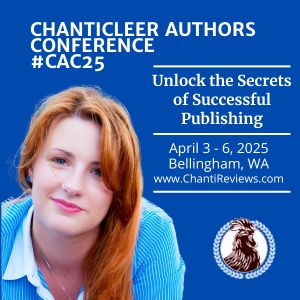|
Listen to or download this article:
|

Interview with Kiffer Brown on DIY MFA
Chanticleer is in the News!
If you haven’t heard the news, Kiffer was interviewed on DIY MFA where she and Gabriela Pereira discuss
- Why now is the best time to be an author
- The difference between a write-up and a review
- The Four Types of Reviews
- How advance reviews help to promote your book
- When you should start sending your book out for reviews
- Plus, Kiffer’s #1 Tip for Writers
You can listen to the full interview on Chanticleer’s under the hood technology that gets increases the digital footprint of each book review published on Chanticleer’s website here or wherever you get your podcasts. Kiffer also gives quick and easy tips about how to get more “Amazon Love” to your book’s Amazon selling page. Below is a quick synopsis of the interview, but tune in to get the full scoop!

So what does all this mean? We have the inside scoop!
The Best Time to be an Author
With millions of books being published every year, it’s harder for an author to be noticed than ever! So why is now the best time to be an author?
Simply put, the number of resources available to authors now are greater than ever before. Not only can Chanticleer help you navigate this vast ocean of publishing, but we provide many of the tools directly. A brief list of our formidable resources are:
- The Chanticleer Int’l Book Awards
- Editorial Reviews
- Manuscript Overviews
- The Chanticleer Authors Conference (April 7-10, 2022)
- The Roost: A Perch for Authors
- Editorial Services
- Promotional Book Stickers
- Quarterly Magazine

Overwhelmed? You can always email us at info@ChantiReviews.com for assistance, or message us directly on Facebook. Of course, one of our primary services is the Editorial Review.
A Write-Up vs A Review
The proof is in the pudding for write-ups vs reviews. A write-up, as said on Merriam-Webster is a review that is intended to be “flattering.” While there’s nothing wrong with one of these, readers will wisely be wary of them as they have a biased tone. By contrast, Editorial Reviews are unbiased and objective, referring to what a text specifically does or does not do – it focuses on the quality of the work. Editorial Reviews are an excellent way for readers to gauge their actual interest in a book, instead of having to read between the lines to see if it’s actually something they’ll enjoy. Both happen and can help with book sales, but an Editorial Review will be more versatile. Let’s dig into that!
The Four Types of Review
Editorial Reviews

These reviews are unbiased and objective, the standard by which readers measure if they’ll want to read a book or not. Chanticleer Editorial Reviews are a professional avenue for your book to be fairly assessed and get people talking about it! We keep up with the latest in Search Engine Optimization technology to maximize the digital footprint of our clients, including cross-posting across social media.
Chanticleer’s Marketing Kits are given to authors whose books receive a 4 or 5-star CBR review. Our kits include personalized Shelf Talkers you can use wherever your print book is sold, as well as samples of our silver-foil Book Review stickers designed to catch readers’ attention.
Typically, the best time to begin submitting your work for an Editorial Review is when you reach the proofing stage. Your reviewer will understand that the book is approaching its final form, and that minor changes will still be made. Your book will be evaluated, not on minor typographical errors, but on how well you’ve realized your story.
Reader Reviews

Close kin of the write-up, these are the kinds of reviews you’ll find everyone on Amazon and Goodreads letting you know how someone who read the book liked it. While some are helpful and provide real insight on the book, many are just a rating from 1-5, and the information relating to your book varies. You can’t be sure this reader is in your audience, even if they read your book! There’s no denying that reader reviews help your book do well, and it’s more of a question of quantity over quality, but they’re tricky to maneuver and guarantee.
Peer Review
One of the most difficult reviews to obtain is that of the peer review, or, as it’s commonly known, the book blurb. This describes an author or someone else in your circle of influence who readers will listen to. J.D. Barker, a regular presenter at The Chanticleer Authors Conference, has networked to have Stephen King blurb his thriller novels, and you can believe that King’s readers sit up an pay attention to that!
Circle of Influence is how Kiffer describes those who surround you that can directly contribute to your success as an author. If you aren’t sure who your circle includes, try writing down ten people who you know you can turn to for advice or support. Each year, you’ll want to grow this circle by another ten people. Kiffer and Sharon Anderson wrote an excellent article about this that you can read here.

JD Barker presented at CAC19 and VCAC21!
While you will, of course, reach out to authors on your level, it’s always good to have a few authors who are doing better than you blurb your book. Obviously, writers at the top of their game will be inundated with blurb requests, so be gentle and patient when asking, even if you never hear back.
The Manuscript Overview
This one is always unexpected, because a review of your manuscript doesn’t come after your book is done (or close to it). However, Kiffer recommends that you do a Manuscript overview around the second of third draft of your book. It’s before you’ve paid someone to painstakingly line edit and proofread your book, but after you feel comfortable with knowing the core of the story, and you know the ideas you want to convey are on the paper. That’s when you’re ready for your overview.
A manuscript overview (MOV) is a broad overview of your manuscript – what’s working and what isn’t from all aspects of your story: structure, plot, pacing, character development, dialogue, etc. Chanticleer can offer guidance on what you need next. Using a manuscript overview before you begin the editorial process will not only save you money in terms of editorial services down the road, but it also will save you time by clarifying where you are in writing your story right now.

Now that we’ve covered the four types of reviews, let’s continue to dig deeper into how you can use your Editorial Reviews
How Advance Reviews Can Support Your Book
So often when authors receive their Editorial Review, instead of inspiration lighting up the night sky telling them what to do next, there’s a strange buzzing sound that surely isn’t dread and uncertainty.

It’s okay! Of course, you’ll want to test bits of your Editorial Review as blurb material for you book. Feel free to be selective and grab multiple sound bites that you like to describe your book. Workshop them with friends and fellow writers in your circle of influence. For the other potential blurbs, you can use those on Amazon, Goodreads, Barnes Noble, and Kobo. Each one of those places has a special location for Editorial Reviews that the author can upload. The reason you use different quotes from you review for these is so that readers who come across your book on multiple platforms have something new to read in each spot. Editorial Reviews used in this way can really help drive presales.
If your book hasn’t been published yet, but is a manuscript that you are sending to agents and publishers, then the Editorial Review can still be used in the same way to market it to those you query regarding your book.
The other big thing is link to your review! Adding links on blog posts and websites increase your SEO rating, and having your digital footprints over a wide path with help readers come across your book online.
When Should you Solicit Reviews?

At least six months in advance. In times where shipping is not being impacted by a global pandemic, it takes about two weeks to receive a shipment of books. And that’s in the best case scenario. Remember, even if all you have left to do is proofreading, your book will still have the following to go through before it can go to print:
- Interior Formatting
- Cover Design
- Proof Copies
The interior formatting and cover design time varies greatly, and the time it takes to receive a galley or proof of your book will be another two weeks for shipping. Six moths will be the minimum amount of time you’ll want to make sure the blurb can appear somewhere on your book and then will be sent out in marketing packages. Bestselling books are often sent out a year or more in advance to receive reviews.
Thanks DIY MFA for the Interview!
Gabriela Pereira is the founder of DIYMFA.com, the do-it-yourself alternative to a Masters degree in writing. She is also a speaker, podcast host for DIY MFA Radio, and author of the book DIY MFA: Write with Focus, Read with Purpose, Build Your Community (Writer’s Digest Books, July 2016).

The book is a wonderful tool for someone interested in an MFA, but sitting on the fence. It walks you through the essentials of what an MFA program provides, and the dives into how to create a similar situation, while providing craft tips on par with the latest advice from top-tier editors. Highly Recommended!
The Chanticleer Authors Conference CAC22
Save the Dates! April 7 – 10, 2022! Register Today!
Seating is Limited. The esteemed WRITER Magazine (founded in 1887) has repeatedly recognized the Chanticleer Authors Conference as one of the best conferences to attend and participate in for North America.
Join us for our 10th annual conference and discover why!











Leave A Comment